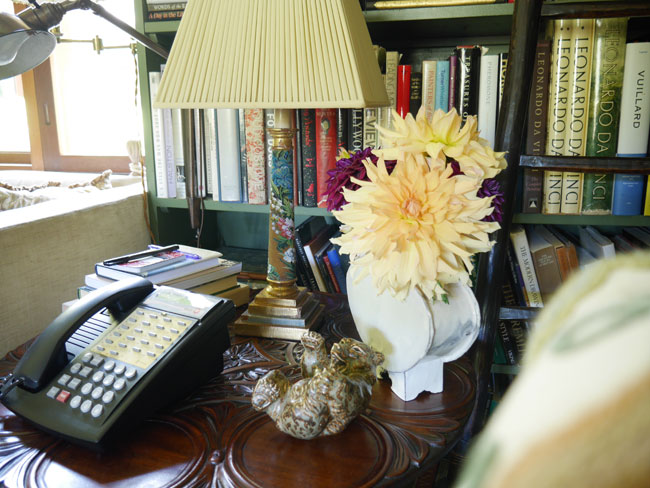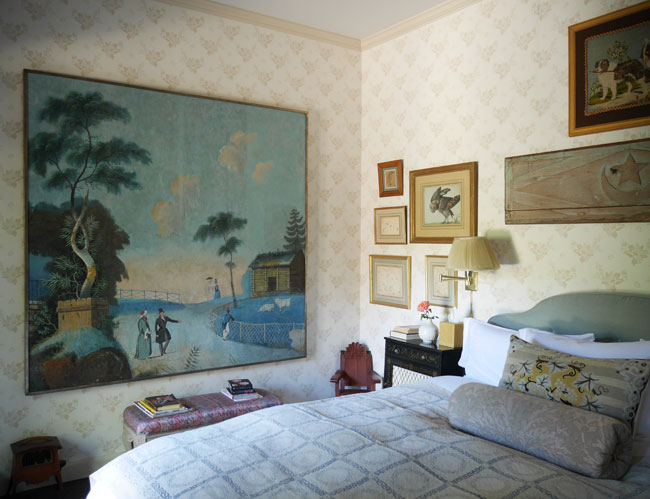Uncategorized
Kitty Hawks – New York Social Diary
We didn’t want to leave the Westchester house that Kitty Hawks and her husband Larry Lederman have spent 24 years perfecting—it is perfect. Although everyone we interview loves their homes, somehow Kitty seemed to love hers with a special and protective intensity. How it has paid off—comfortable rooms full of lovely things, a house surrounded by gracefully designed gardens that lead down to a lake of green water, shining in the early autumn sunlight.
The daughter of socialite Slim Keith and filmmaker Howard Hawks, Kitty struck out on her own, going to college and eventually becoming a designer and a teacher—she taught traditional residential interior design at Parsons for seven years. Nowadays, it’s gardening and contentment and quiet evenings by the fire, which makes her sound a bit dull. She isn’t.
So I’m curious about your name—was it a deliberate reference to the single-engine airplane, Kitty Hawk?
Well, it’s not Kitty Hawk, it’s Kitty Hawks because my father was Howard Hawks. But my mother … she had a lot of humor and I think she thought, this is one [name] that no one will forget.
People must drive you crazy asking about your name.
They used to but now we’re in a whole new generation and they’ve never heard of the Wright brothers. [The Wright brothers tested and flew aircraft in and around Kitty Hawk in North Carolina]
What sort of homes did you grow up in yourself?
I had a very privileged upbringing. The first house I remember was the house in Manhasset, where my mother was living with my stepfather. It was not unlike this house—very suburban
I’m not sure I would describe this house as suburban …
Well, it was in the suburbs. The adjoining property belonged to Babe Paley, who was one of my mother’s best friends—so I was exposed to that house. I don’t think at the time I understood the enormity of what I was seeing, a house like that. One of my most outstanding memories was when my mother had divorced my stepfather and then married an Englishman and moved to England. I would go for the holidays. He had a wonderful house in Norfolk—a modest house now that I know other English houses. My mother basically modernized it.
Ooh, did she make the house warm? That would be a first for England.
She did! She put in central heating and nice bathrooms. She made it so comfortable. We went one weekend to Blenheim because she was friends with the Duke of Marlborough. And by then I was old enough to get it. Although it was hard to miss! The thing that was the most outstanding was that the long room was comfortable. There were sofas with slipcovers by the fireplaces. There were flowers and books. And I remember thinking, if this can be comfortable, there is no excuse for not making anywhere comfortable.
Did you ever live in a tiny apartment?
Oh absolutely. I loved my little apartment on 63rd Street between Lex and Third. When I first moved to California, I had a wonderful little apartment on Hayward Avenue. I remember going to Woolworths and buying on sale these sheets that were black and had huge cabbage roses, yellow, pink and blue on them. I stapled them to the wall in the dining room. I would give these parties every Friday where I would serve chili and baked potatoes in this tiny little apartment with these black cabbage rose things on the wall and everybody, I mean everybody, was so stunned. That’s kind of how things work out there – everyone hears there’s a new girl in town who makes great chili … so they come … Jack Nicholson and Warren Beatty …
Wow, you made chili for Warren Beatty? Did you play down who your parents were?
I would always say they are my parents, and certainly it doesn’t hurt—but I am not them. I knew I was not going to be my mother. She wanted me to be a debutante in England and I said that’s not going to happen. She was amazed when I got into college or that I even wanted to go college.
Why?
Because it wasn’t a part of her life when she was growing up. I think she thought, you know, “She’s a good looking girl and she could have a debutante party, get married.” She thought I could have had a social life the way she had—social but also a fantastic life. She led a life full of adventure and glamour. I didn’t know my father well at all. Many years ago I read a biography and he had studied as an engineer—and I thought that explains a lot because I’m more serious. It explains why I was drawn to architecture. It explains why I was drawn to design. And I wasn’t that comfortable in social situations. I wasn’t gregarious the way my mother was.
And you’re candid.
And I’m candid, which doesn’t necessarily make you the best dinner partner.







Did you sense that people wanted something from you because of who your parents were?
I could always tell if the efforts being made and the compliments being given were bogus or not. When I began to get traction of my own, I could just tell. But I’m very willing to step up to the plate if I can help somebody.
Your mother was so very glamorous—what are your thoughts on glamour?
I think it is a thing you have. I’ve always thought of glamour as authority, in terms of authority with which you wear something, the authority with which you project yourself. In the old days, you saw it in someone like Katherine Hepburn. It’s almost impossible now—George Clooney has glamour … Angelina Jolie … but not many more. I mean Lauren Bacall was 19 years old when she did “To Have and Have Not”. Have I seen a 19-year-old like that? Have you? It was a different time. It was time when being a grown-up was what you wanted to be.
And it was your father who pioneered this idea of strong, gutsy female lead characters, right?
Pioneered is the right word. And my mother was the role model. When you look at those movies, even the comedies, the difficulty of what they were doing with overlapping dialogue. When you really look at how the movies where shot with one camera here, moving from left to right without any cut, they’re having to remember very substantial amounts of dialogue. It’s very complicated and when you look at something like “His Girl Friday” or my favorite, “Bringing Up Baby” you begin to understand how revolutionary he was.
Did your mother like animals as much as you do?
I don’t know if she liked them as much because it’s hard to like an animal as much as I like an animal but yes, she always had dogs. She loved animals.
She obviously had a really great eye.
She had a great eye and made a lovely home no matter where she was living.
We read that when it comes to your design, one of things that you’re interested in is Japanese culture – we can see certain influences in this room—can you say what draws you to Japanese objects?
I love Japanese culture. There’s no quote. I don’t try to copy it. There are objects. There are little pieces of furniture. There are vases and the way the flowers are arranged. It’s just a sensibility that makes its way in. There’s a resonance that one feels—I don’t feel it towards Indian culture; I don’t feel it towards Chinese culture, really. [Japanese culture] is refined and thoughtful and it has a certain affection towards animals—and that, of course got me.
It’s interesting to hear you talk about the influence another culture brings to design because I was reading something written by an architect who goes over all over the world to do commissions and each time he hopes that he can bring in elements of the local culture but each time he finds that his clients all want the same thing: lots of glass and the linear contemporary look. He says it is as if they all want to bury their culture.
It’s so discouraging. The only place I’ve been that really felt like it was not of the rest of the world was Cuba—because they haven’t been allowed to do it. When you go there, it reminds you of what travelling used to be like.
Alex Papachristidis said to us that if people are going to be spending money on interiors now, they don’t want to spend it on furniture but they want to spend it on art.
I know. I worked for somebody and I wanted to put Oriental rugs on the floor but he said they would compete with the art. I said they wouldn’t. They are works of art. And I turned what had been a relatively soulless gallery into a much more comfortable living room. The art was beautiful but the room became more beautiful because it wasn’t so intimidating. It’s pretty overwhelming if you’re sitting next to a Rothko—not that I wouldn’t like one!



Don’t you think those people who own Rothkos want to intimidate you!? Or at least impress you?
Oh yes! But the people who have those kinds of houses, don’t spend a lot of time in them. They work a lot and once in a while they have a big party. It’s not like this house, even though this is a fairly large room, it’s very comfortable to be in it by yourself, like in the winter with the fire lit. All the little things I get, I make into a story. I animate them.
You taught at Parsons—how was that?
I was amazed at Parsons. I taught there for seven years and I was the one person who was teaching traditional residential interior design.
How receptive were students to that?
Not too … when I took the job, the first thing I asked was, “Am I allowed to fail them?” There are schools where you are not allowed to in case the parents sue.






So did you fail anybody?
Well they didn’t do the work. They complained. One of them said, I didn’t do this project because I wasn’t here for those two lectures. I said, that’s not my problem, is it? You haven’t done the work and what you have done is pathetic … I was scary.
You are quite scary …
I can be wonderfully nice! I could have adopted some of them! But I had no patience for the ones who didn’t work. But when they did well and for those who were curious, I took them all over New York! The hardest thing was to get them into the library or to go to the bookstore. Because when you look at a book, you see all kinds of things you didn’t know were there. If you go online, there’s no accident. It’s very purpose-driven. I was just so disappointed that I couldn’t get them to love it the way I loved it.
So what do you do when you’re here, just being home?
The garden … over the 24 years we’ve been here it’s turned into a passion. All winter long, we look at catalogs. I do get dirt under my fingernails—but I’m better pruning. I’m better upright these days.
